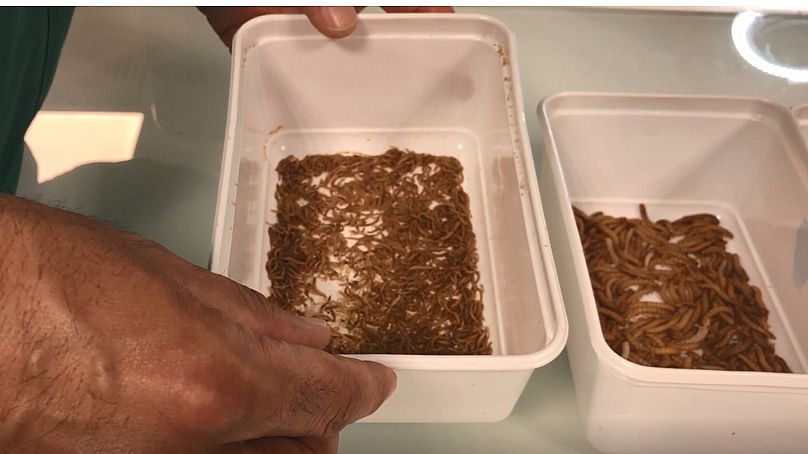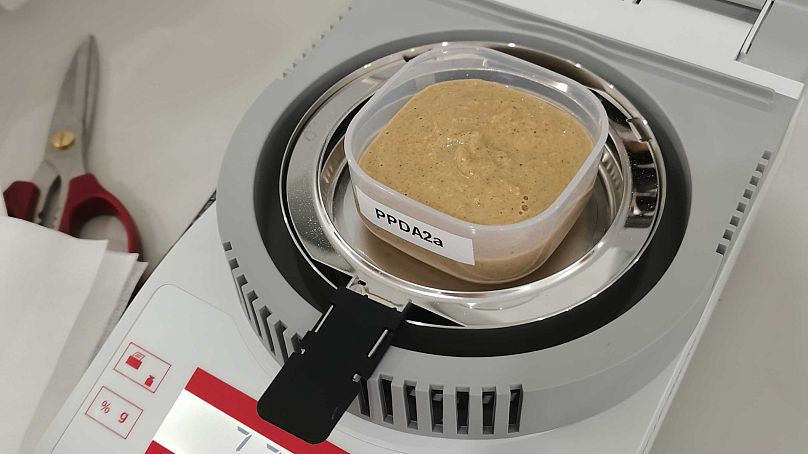It might seem disgusting at first, but experts claim insects could cut emissions and food costs.
Will insects be a staple food in the future? Several companies in Europe are betting on it.
From lower emissions to reduced land use and a way to contribute to the circular economy, they claim a range of benefits. But convincing Europeans to eat insects isn’t easy.
Almost 60 per cent of people believe that they could become an alternative and sustainable source of protein in the future, according to a study from the Universitat Oberta de Catalunya published earlier this year.
But more than four in five people weren’t willing to add them to their diets listing a range of reasons from disgust to doubts about food safety.
Antoine Hubert, co-founder and CEO of French insect protein pioneer Ÿnsect, says “big things” need to change in our food systems, from the field to the fork.
“Food is the first contributor to the biodiversity collapse we are seeing today in the past few decades, but also the second contributor to climate change.”
He believes that insects - along with plant protein and reducing food waste - have an “important role” to play on the road to a sustainable food system.
Can insects reduce the environmental impact of food?
Hubert says one of the main things people are interested in when it comes to Ÿnsect’s products is the environmental impact.
“If you look at the products, the proteins compared to other animal proteins, it's more than 95 per cent less impact than beef, for instance, with carbon emissions. And it goes to more than 95 to 98 per cent or so of reduction of water consumption from beef to pigs.”
The vertical way in which Ÿnsect farms also means that they are using 98 per cent less land to produce the same amount of protein.
“So you're saving you a lot of space, which is good for the biodiversity, you're reducing drastically carbon emissions. We're reducing drastically water consumption and the same for the oceans,” Hubert explains.
“Each tonne of our products can feed also fish and avoid the fishing of five tonnes of wild fish.”
Can insects contribute to a circular economy?
Nathalie Berezina, chief technology officer of EU-based insect-farming company FlyFeed, says that this way of farming protein can also contribute to the circular economy.
“Mealworms, they are mainly feeding on leftovers of cereals, while wax moths… it's able to feed itself on the plastic waste. And the black fly, it's an insect that feeds on the organic waste like leftovers of fruits or vegetables,” she explains.
It makes the insects, “really powerful” for the circular economy as they can even feed on post-consumer waste.
“That's why we should use them more than we’re using them right now, because those animals have developed a very specific system which allows them to digest different types of food based on leftovers.”
Can insect protein help with more than just emissions?
She says the main difference compared to animal agriculture is what the insects eat.
“The most important cost for all farm animals is usually within the substrate that they are consuming,” explains Berezina.
“[The insects] are feeding on leftovers, on waste and mixtures of those things that are difficult to be digested by other types of organisms.”
She adds that these are small animals with short lifespans, meaning they grow in much less time. The conditions to grow insects are often quite simple too and, if you choose the right country to produce them, require very little change to the ambient climate.
Combined with the cheap substrate, this could make them a less expensive way to produce protein and tackle food crises, Berezina says.
What obstacles do insect farmers face?
One of the biggest things standing in the way of insect protein in the EU was regulation. But this has just changed with a number of products approved for human consumption in the last year.
“This recognition is one of the major milestones of the company in the past ten years,” says Hubert. “Nothing was approved so far in Europe.”
But Ÿnsect’s products have been given the green light across the EU by the European Food Safety Agency. Hubert believes this will mean the market for human food can now grow rapidly.
“The second limiting factor was the technology and the quantities. Now we have quantities. We can provide enough in the European market,” Hubert adds.
Can Europeans be convinced to eat insects?
Probably the biggest barrier for consumers is the idea of eating insects.
“Insect by itself is not something which Europeans are used to consuming, so you have this kind of 'yuk' effect,” Berezina says.
But, coming from France, she points out that many people are already used to eating snails, frogs and oysters.
“I don't know whether you have ever tasted snails, but actually, I have no idea, how snails actually taste. Because all that you have a taste of is garlic butter that is coming with the snails.”
Berezina believes that making things tasty is all that is needed to help incorporate insects into different dishes.
Ÿnsect is already looking at what kinds of insect protein people will and won’t eat.
“The last [barrier] was just to define products people will eat from traditional whole insects - which a majority of people will not eat - to something very common for you or for your place: burgers, meatballs, falafels, pasta,” Hubert says.
"Our purpose is not to convince everyone, it's just to propose this food…and they can choose it among other solutions there: plants, algae, fungi and just all the traditional products we have already, and meat and fish and plants.”
Watch the video above to learn more about how insect protein is produced.













